Juan Pablo Duarte | |
|---|---|
 Oil portrait of Juan Pablo Duarte by Dominican artist Abelardo Rodríguez Urdaneta. | |
| Born | January 26, 1813 |
| Died | July 15, 1876 (aged 63) |
| Resting place | Altar de la Patria |
| Nationality | Dominican |
| Occupation(s) | Activist, writer, military general, politician, educator, independence leader |
| Years active | 1833 – 1876 |
| Organization | La Trinitaria |
| Title | Father of the Nation |
| Political party | Central Government Junta |
| Movement | La Trinitaria (Dominican Republic) |
| Parents |
|
| Relatives | Vicente Celestino (brother) Maria Josefa (sister) |
| Awards | National hero |
| Honours | Order of Merit of Duarte, Sánchez and Mella |
| Military career | |
| Allegiance | |
| Service/ |
|
| Rank | General |
| Battles/wars | Dominican War of Independence Dominican Restoration War |
| Signature | |
 | |
Juan Pablo Duarte y Díez (26 January 1813 – 15 July 1876)[1] was a Dominican military leader, writer, activist, and nationalist politician who was the foremost of the founding fathers of the Dominican Republic and bears the title of Father of the Nation. As one of the most celebrated figures in Dominican history, Duarte is considered a national hero and revolutionary visionary in the modern Dominican Republic, who along with military general Ramón Matías Mella and Francisco del Rosario Sánchez, organized and promoted La Trinitaria, a secret society that eventually led to the Dominican revolt and independence from Haitian rule in 1844 and the start of the Dominican War of Independence.
Born in a humble working class family in 1813, his desire for knowledge and his dreams of improvement led him to Europe, where he strengthened his liberal ideas. These ideas formulated the outline for establishing an independent Dominican state. Upon returning, he voluntarily dedicated himself to teaching in the streets, improvising a school in his father's business, determined that the people of his era assimilate his ideals of revolutionary enlightenment.
Duarte became an officer in the National Guard and a year later in 1843 he participated in the "Reformist Revolution" against the dictatorship of Jean-Pierre Boyer, who threatened to invade the western part of the island with the intention of unifying it. After the defeat of the Haitian President and the proclamation of the Dominican Republic in 1844, the Board formed to designate the first ruler of the nation and elected Duarte by a strong majority vote to preside over the nation but he declined the proposal, while Tomás Bobadilla took office instead.[2]
Duarte helped inspire and finance the Dominican War of Independence, paying a heavy toll which would eventually ruin him financially. Duarte also disagreed strongly with royalist and pro-annexation sectors in the nation, especially with the wealthy caudillo and military strongman Pedro Santana, who sought to rejoin the Spanish Empire. From these struggles, Santana emerged victorious while Duarte suffered in exile, despite coming back a few times, Duarte lived most of his remaining years in Venezuela until his death in 1876.
Early years
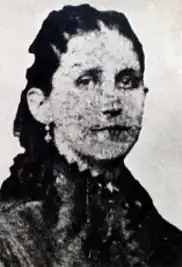
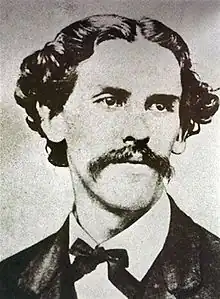
Duarte was born on 26 January 1813 in Santo Domingo, Captaincy General of Santo Domingo[1] during the period commonly called España Boba. In his memoirs, La Trinitaria member José María Serra de Castro described Duarte as a man with a rosy complexion, sharp features, blue eyes, and a golden hair that contrasted with his thick, dark moustache.[3]
Duarte was born into a middle-class family that was dedicated to maritime trade and hardware in the port area of Santo Domingo.[4] His father was Juan José Duarte Rodríguez, a Peninsular from Vejer de la Frontera, Kingdom of Seville, Spain, and his mother was Manuela Díez Jiménez from El Seibo, Captaincy General of Santo Domingo; three of Duarte's grandparents were Europeans.[lower-alpha 1] Duarte had 9 siblings: his eldest brother, Vicente Celestino Duarte (1802–1865), a tall, long-haired brunette man, was a store owner, woodcutter and cattle rancher who was born in Mayagüez, Puerto Rico; one of Duarte's sisters was Rosa Protomártir Duarte (1820–1888), a performer who collaborated with him within the Independence movement. In 1801 the Duarte family migrated from Santo Domingo to Mayagüez, Puerto Rico.[6] They were evading the unrest caused by the Haitian Revolution in the island. Many Dominican families left the island during this period.[7] Toussaint Louverture, governor of Saint-Domingue (now Haiti), a former colony of France located on the western third of Hispaniola,[8][9] arrived to the capital of Santo Domingo, located on the island's eastern two-thirds, the previous year and proclaimed the end of slavery (although the changes were not permanent). At the time, France and Saint-Domingue (the western third of the island), were going through exhaustive social movements, namely, the French Revolution and the Haitian Revolution. In occupying the Spanish side of the island L'Ouverture was using as a pretext the previous agreements between the governments of France and Spain in the Peace of Basel signed in 1795, which had given the Spanish area to France. Louverture wanted to convert the old Spanish institutions to French and re-establish the plantation economy on both sides of the island.
Upon arrival in Santo Domingo Norte, L'Ouverture immediately sought to abolish slavery in Dominican territory, even though slavery was abolished in 1821 per Spanish Haiti constitution. Puerto Rico was still a Spanish colony, and Mayagüez, being so close to Hispaniola, just across the Mona Passage, had become a refuge for migrants from Santo Domingo like the Duartes and other native born on the Spanish side who did not accept Haitian dictatorship. Most scholars assume that the Duartes' first son, Vicente Celestino, was born here at this time on the eastern side of the Mona Passage. The family returned to Santo Domingo in 1809, however, after the Spanish reconquest of Santo Domingo, led by governor- general Juan Sánchez Ramírez, that decisively crushed French rule in Santo Domingo, but returned to Spanish rule.
In 1819, Duarte enrolled in Manuel Aybar's school where he learned reading, writing, grammar and arithmetic. He was a disciple of Dr. Juan Vicente Moscoso from whom he obtained his higher education in Latin, philosophy and law, due to the closure of the university by the Haitian authorities. After the exile of Dr. Moscoso to Cuba, his role was continued by the priest Gaspar Hernández.
Ephemeral Independence
First Dominican independence, 1821
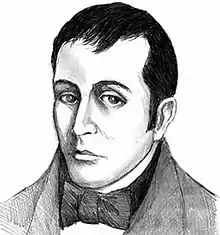
In December 1821, when Duarte was eight years old, members of a Creole elite of Santo Domingo's capital proclaimed its independence from Spanish rule, calling themselves Haití Español. Historians today call this elite's brief courtship with sovereignty the Ephemeral Independence. The most prominent leader of the coup against Spanish colonial government was one of its former supporters, José Núñez de Cáceres. These individuals were tired of being ignored by the Crown, and some were also concerned with the new liberal turn in Madrid.
Their deed was not an isolated event. The 1820s was a time of profound political changes throughout the entire Spanish Atlantic World, which affected directly the lives of middle-class like the Duartes. It began with the conflictive period between Spanish royalists and liberals in the Iberian Peninsula, which is known today as the Trienio Liberal. American patriots in arms, like Simón Bolívar in South America, immediately reaped the fruits of Spain's destabilization, and began pushing back colonial troops. Even conservative elites in New Spain (like Agustín de Iturbide in Mexico), who had no intention of being ruled by Spanish anticlericals, moved to break ties with the crown in Spain.
Many others in Santo Domingo wanted independence from Spain for reasons much closer to home. Inspired by the revolution and independence on the island, Dominicans mounted a number of different movements and conspiracies in the period from 1809 to 1821 against slavery and colonialism.[10] Several towns asked for Haiti to help with Dominican independence weeks before the experiment of Haití Español even began.[11]
The Cáceres provisional government requested support from Simón Bolivar's new government, but their petition was ignored given the internal conflicts of the Gran Colombia.[12]
Annexation by Haiti

Meanwhile, a plan for unification with Haiti grew stronger. Haitian politicians wanted to keep the island out of the hands of European imperial powers and thus a way to safeguard the Haitian Revolution . Haiti's President Jean-Pierre Boyer sent an army that took over the eastern portion of Hispaniola. The Spaniards residing in Santo Domingo, especially those of Catalan origin, welcomed the country's incorporation into the Republic of Haiti. Thus, when Boyer arrived in the city at the head of his troops, the Spanish traders sent him a letter in which they adhered to the new order that was implemented. However, Duarte's father was the one of the Spanish merchants in the city who refused to sign the document and, according to several documents, he chose to get involved in separatist conspiracies that tried to take shape during the initial years of Haitian domination, though it never materialized.
On 6 January 1823, Boyer decreed that all young men between the ages of 16 and 25 would be drafted into the Haitian army. This measure caused the University of Santo Domingo to lose its students and consequently had to close its doors. On 14 November 1824, Boyer established French as the official, sole and obligatory language in the acts of the Courts, the Civil Registry and public notaries throughout the island. Struggles between Boyer and the old colonial helped produce a migration of planters and elite. Following the bourgeoisie custom of sending promising sons abroad for education, the Duartes sent Juan Pablo to the United States and Europe in 1828 .
Revolutionary origins
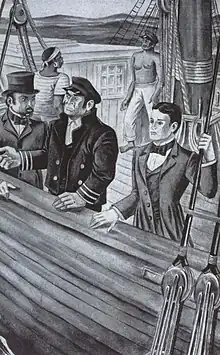
For his trip, Duarte was accompanied by Pablo Pujols, a Catalan merchant who was also a family friend of the Duartes. Pujols had lived in the country for some time, and for the trip, he agreed to be the tutor for the young Duarte. However, as Duarte boarded the ship, the captain reproached the two travelers due to the fact that the inhabitants of the Spanish part of the island were now living under Haitian domination. He even asserted that he would only board him unless Duarte told him that he felt no shame in being "Haitian." Although Duarte responded that he was Dominican, the captain harshly boasted that the Dominicans were cowards for submitting to Haitian yoke, and therefore, was undeserving of an identity, expressing the following words: "You have no name, because neither you nor your parents deserve to have one, because, cowardly and servile, they bow their heads under the time of their slaves." This moment completely moved the still teenaged Duarte, who would readdres years later that these humiliating words led him at that very moment to the resolution to fight for Dominican Independence.[13] He then assured the captain that he would not rest until his people were free.[14]
Era of Enlightenment
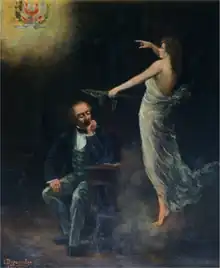
Duarte left the country for the first time for Spain as a teenager. Before coming to Europe, where he would go to study, he spent a brief time in the United States. Although it is believed that he entered North America through New York, another version indicates that he did so through Providence, Rhode Island, on 2 July 1829, and that from there he went to the city known today as the Big Apple. In New York he studied English, a language Mr. Groot had introduced him to in Santo Domingo. In addition, Rosa Duarte reports in her "Notes," he began to study Universal Geography with Mr. W. Davis, who gave him classes at home. In England, specifically Southampton, from where he would go to London was his gateway to Europe, a continent where he would study philosophy, history, law, political science and geography, Pedro Troncoso Sánchez quotes in "Duartian Episodes." His tour of the Old Continent continued in France, where he arrived at Le Havre and then touched Paris. In Gallic land he perfected his French, a language he had studied in Santo Domingo at the hands of Monsieur Bruat.[15] While attending a banquet in Hamburg, through a lodge called Oriente, he was introduced to Freemasonry, absorbing ideals of liberty, equality and fraternity.
In Europe, convulsed in the era of romanticism, liberalism, nationalism and utopian socialism, it was engulfed with revolutionary atmospheres at the time. Having thrown himself into these scenes of European radicalism, Duarte himself had the pleasure of witnessing the new regimes of liberty and rights that had arisen after the French Revolution; He was intrigued by the new changes produced in Germany and France, but none was caught his interest more that that of Spain, of which reforms introduced by Cortes of Cádiz. He would remain in Barcelona for the rest of his travels, where it is believed that he studied law.[16]
It was then that his political ideology began to take shape, in which nationalism and liberalism merged on a romantic background: Duarte understood that the Dominican people had their own identity and had the absolute right to bring about political independence. Since the beginning of the 16th century, the Dominicans, despite the economic disadvantages, have a history of rebelling and triumphing battles against Dutch, British, French, and Spanish forces, (the latter two of which in recent decades, were expelled from Santo Domingo by Dominican rebels in 1809 and 1821 respectively). This time, Duarte firmly believed that the Dominicans would now have to rise up arms against the fierce might of the Haitians. Upon the success of this goal, the newly independent nation would be organized on the basis of the institutionalism of representative democracy. Having formalized these ideals, the enlightened Duarte returned to his homeland In 1833.[2] From Barcelona he arrived in Puerto Rico, then to Saint Thomas, and from this island, to his native country.
With his return, Duarte returned to his hometown of Santo Domingo, where he devotes himself to putting his newly formed ideals to test, while at the same time, working in his father's business. According to historian Orlando Inoa, backed by records from the lodge named Constante Union No. 8, a lodge that was chartered through the Grand Oriente of Haiti, Duarte became a freemason at the legal age of 21. He was said to have been appointed as the Architect Decorator of this lodge. (Matías Ramón Mella, a businessman and native of Santo Domingo, was also a member of this lodge. Mella would later become one of Duarte's key collaborators). He had even joined the Haitian National Guard, where he acquired military training, as well as studying the military tactics of occupying forces. He eventually reached the rank of colonel.
He leads an intense social life that allows him to come into contact with many important sectors of the urban communities. He witnessed marriages, sponsors, baptisms and attended meetings of a cultural nature. This experience of society is what moved him to realize that within the population, there is a patriotic feeling that rejects the Haitian presence in the country. His merit, not only as a patriot, but also as a political organizer, lies fundamentally in the fact that he was well aware of the historic moment that accumulated in Dominican society at that time; the reluctance of its most decisive layers to accept Haitian rule, of which by now was becoming more despotic and unruly.[17]
His ideas found greater echo within the middle class. While cultivating his spirit, Duarte did not stop transmitting the knowledge he acquired to the youth of his native city. For four consecutive years, from 1834 to 1838, he offered language and mathematics classes to a group of humble young people who went every afternoon to the warehouse located on La Atarazana street. The young master's popularity grew among a large part of the population. Many of his disciples began to feel a fervent attachment to him. In a short time the La Atarazana warehouse becomes the headquarters of a revolutionary junta. Duarte's word has penetrated the hearts of a group of young idealists and little by little the wills of all have merged into a common aspiration: that of separating the Dominican part of the island from the Haitian part. Duarte launched the idea and it was enthusiastically received by those of his disciples who had stood out the most for their fervor for the principles he preached and those who testified to his most self-sacrificing fidelity.
Struggle for independence
Founding of La Trinitaria
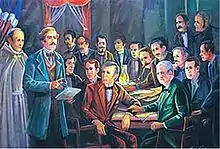
On 16 July 1838, in the place of Arzobispo Nouel Street, (in front of the Church of Carmen), Duarte and others established a secret patriotic society called La Trinitaria, which helped undermine Haitian occupation. Named after the Holy Trinity, this movement, as described by his sister Rosa, was referred as a youth movement, due to the fact that most of the members were very young. Some of its first members included Juan Isidro Pérez, Pedro Alejandro Pina, Jacinto de la Concha, Félix María Ruiz, José María Serra, Benito González, Felipe Alfau, and Juan Nepomuceno Ravelo.
At the meeting, Duarte told his men firmly:
We are convinced that there is no possible merger between Dominicans and Haitians. We are and will be two different peoples. Our destiny is to be independent, absolutely independent. Our society will be called La Trinitaria because it will be made up of groups of three and we will place it under the protection of the Holy Trinity. Our motto: God, Country and Freedom. My friends, we are here to ratify the purpose that we had conceived of conspiring and making the people rise up against the Haitian power, in order to establish ourselves as a free and independent State with the name of the Dominican Republic. The white cross that will carry our flag will tell the world that the Dominican people, upon entering the life of freedom, proclaim the union of all races through the bonds of civilization and Christianity... The situation in which we will place ourselves will be very serious, and all the more so since once we are already on this path, going back will be impossible. Now, at this moment there is still time to evade commitment. Therefore, if anyone wanted to separate...
But before he could continue, the men suddenly erupted, declaring the fight for independence as a necessity and that there are no compromises. Duarte, satisfied with the men's response, took this as proof their commitment to the cause. After this, he took out a document from his pocket, to which Duarte had his men sign with blood. But before the men recited an oath, pledging allegiance to the cause:
In the name of the most holy, most august and indivisible of Omnipotent God, in the hands of our president Juan Pablo Duarte, to cooperate with my person, life and property for the definitive separation from the Haitian government, and to establish a free, sovereign and independent Republic of all foreign domination, which will be called the Dominican Republic, which will have its tricolor flag, in red and blue quarters, crossed with a white cross. Meanwhile, we Trinitarians will be recognized with the sacramental words: God, Homeland and Liberty. So I promise before God and the world: if I do, God protect me, and if not, i take it into account, and my fellow members punish me for perjury and treason, if I sell them.
After reciting the oath, each of the men proceeded to sign the document, in addition to placing a cross before each other's name. Duarte then said to his men:
The cross is not the sign of suffering; it is the symbol of redemption. La Trinitaria is constituted under its aegis, and each of its nine partners is obliged to reconstitute it, as long as one exists, until fulfilling the vow we make to redeem the homeland from the power of the Haitians.
La Filantrópica and La Dramática
Later, Duarte and others founded a society called La Filantrópica, which had a more public presence, seeking to spread veiled ideas of liberation through theatrical stages. This group went by the motto Peace, Union, and Friendship. Some of their plays included: Free Rome by Italian playwright Vittorio Alfieri, La Viuda de Padilla by Francisco Martínez de la Rosa, A Day of the year 23 in Cádiz by Eugenio de Ochoa. The Haitian governor, Bernard-Philippe-Alexis Carrié, at first, wasn't suspectuful, so he ignored the performances. But the public flocked to the theater with such enthusiasm and the actors caused such delirium in the audience that Alexis Carrié was alerted by his spies. The first impulse of the occupation authorities was to suspend the activities of the movement and close the theater.[18]
After several failed attempts, the unsatisfied Trinitarios founded La Dramática. In this new society, all the members devoted themselves to acting.[17] Many of the people enjoyed these activities and at the same time, learned through the representation of theatrical works they directed. They staged the struggle of a people to free themselves from an oppressive government.[18]
Brief alliance with the Haitians
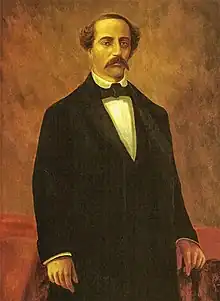
The years 1842-1843 are defining for the creation of propitious conditions that culminated with the moment for Dominican independence. Catastrophic natural phenomena such as the earthquake that affected Haiti on 7 May 1842 and that it left the city of Cape Haitian in the north practically destroyed and that it equally affected Santiago and other northern cities in the eastern part. Nearly 5,000 deaths were recorded in said earthquake and accusations of incapacity and insensitivity of the authorities in handling said natural event that influenced the beginning of its political deterioration that had already begun before.[19] Added as a catastrophe, there was a fire in Port-au-Prince that left it in ruins in January 1843, and a political unrest that had been gaining ground was combined with shortages and the economic-commercial crisis that accompanied it.[19] The political attrition of Jean-Pierre Boyer produces ruptures within Haiti and also in the eastern part of the island with separatist movements that sought to overthrow Boyer on one side, and on the other side, sought to make the Spanish part of the island take the opportunity to gain independence.
There were coincidences and differences in purposes.[19] For Duarte, he felt that a shudder was needed, since the Trinitarios could not manage to transfer its influence from the circle of young people to the upper urban sector. This allowed them to move to shift their attentions towards a new movement: La Reforma. Upon learning of the conspiracy led by deposed liberal deputies in Les Ceyes and other parts of the South, Duarte arranged for Mella to move to that region and reach agreements with Boyer's enemies. Mella fulfilled his duty, and after a brief visit, he returned to Santo Domingo a day before the insurrection that began of 27 January 1843. After military operations, Boyer resigned on 13 March 1843.[20]
Nearly two weeks later, news reached Santo Domingo about Boyer's fall. Following this, a mobilization of the Trinitarios and the Haitian liberals residing in the city hurled into the streets in repudiation of despotism and hailed Dominican triumph. The conservatives, however, were disturbed by this union, accusing Duarte of being "Colombian," alluding to the prior independence leader, José Núñez de Caceres. In response to this, Duarte strongly emphasized that independence was not what was sought at that time, but the Reformation. (Duarte, who wanted to carry out his plan discrete, alluded this for the purpose of not publicly speaking of the true conditions of proclamation for independence).[20]
Meanwhile, the Haitian authorities of the city, headed by Governor Carrié, opposed the popular movement and a shootout occurred in the Plaza de Armas (today Parque Colón) when the crowd approached his residence to demand his resignation. Many protesters hid, while others, like Duarte, marched towards San Cristóbal, where important conspirators were located. In that town, they received reinforcements from other places in the south, causing Carrié to resign from office. Étienne Desgrotte, the leader of the Haitian liberals in Santo Domingo, was appointed governor. After this, a popular board was formed by Alcius Ponthieux, who assigned Duarte, in addition to Pedro Alejandro Piña and Manuel Jiménes, as members to the board. Duarte was entrusted with the mission of expanding the work to the localities from the east.[21] In these elections the Trinitarios obtained massive support, they became responsible for the new constitutional reform with the Haitian revolutionaries and an article of this constitution separated both groups because it denied rights to the citizens of the Spanish side, among others, the issue of the use of the language Spanish and possession of real estate. By now, Duarte and the Trinitarios now had the edge for their cause of independence.
Birth of a new nation
First exile and declaration of independence
This alliance of purposes, however, did not last long. The true motives of Duarte had reached the ears of Charles Rivière-Hérard, who responded with the call of repression of the revolutionaries on the eastern side of the island. The fights started as a result of these differences produced the reaction of the new Haitian government and under the command of Hérard, he launched it against the Trinitarios, commanding two battalions that accompanied him from the city of Port-au-Prince.[19]
During the month of July 1843, the military forces of the Haitian Government intensified the persecution against the Trinitarios. On 24 July 1843, the residence of the family of Juan Pablo Duarte and that of his uncle José Díez, were raided by Haitian soldiers who were trying to locate the Trinitarian leader. The requisition was led by the Haitian commander Hipólito Franquil, who, according to Rosa Duarte, "was accompanied by a large troop of which one part surrounded the block and the other entered the house divided into two rows of two in background; a line of armed soldiers entered through the main bedroom into the inner rooms; and the other extended from the street through the room to the corrals." That day Duarte and several of his companions managed to escape by jumping through the patios of neighboring residences until they reached the house of Mr. Teodoro Ariza. They later moved to Pajarito, (present day Villa Duarte, Santo Domingo Este), where they took refuge in the house of Spanish citizen Pascual C. López. They left there at 10 p.m. that same day.[22]
Eventually, Duarte had received information from one of his "repentant persecutors" that his head had a price and for this reason, the person who gave him the confidence suggested that he leave Santo Domingo. According to the informant, the Haitian government gave three thousand pesos and the colonel's epaulette “for the leader of the revolution”, but many believed that the amount of the offer was low. Juan Pablo Duarte and Pedro Alejandrino Pina left the Pedro Cote residence, in the company of Juan Alejandro Acosta and another friend that Rosa Duarte does not identify.[22] Finally, on 2 August 1843, Duarte decided to leave the island for Curaçao due to his insurgent behavior, where he was surprised by the news of his father's death on 25 November of that year. Then, Duarte tells his mother to sell the family business to finance the separatist revolution, to which his mother is opposed at first.
In his absence, Francisco del Rosario Sánchez had to take the reins of the separatist movement and make an alliance with the conservative sector headed by Tomás Bobadilla y Briones and Buenaventura Báez, resulting in the Manifesto of 16 January 1844. All of this, along with the help of many who wanted to get rid of the Haitians who ruled over the Dominicans, triumphed, as the Dominicans successfully expelled the Haitians out of the country, leading to the proclamation of independence on 27 February 1844. In accordance to Duarte's wishes, a new republican government, once again free of foreign control, was established, and Independent Santo Domingo was officially renamed as the Dominican Republic.
First return to Dominican Republic
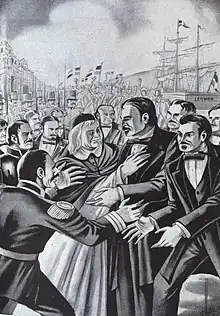
With the purpose of preparing the return of Duarte, a commission was formed, headed by Juan Nepomuceno Ravelo, in charge of bringing the patrician back to his homeland. Four days later, on 15 March 1844, Duarte entered the Port of Santo Domingo, where he was acclaimed by the people. With him, he brought weapons and war materials that he was able to obtain on a trip to Curaçao. His presence caused great joy among his followers and he was received by a procession that paid him the honors of a head of state. Archbishop Tomás Portes Infante greeted the Patrician with these effusive words: "Save the Father of the Nation!" [23]
Duarte was proclaimed General in Chief of the Armies of the Republic, but the Government appointed him Brigadier General and Member of the Central Government Junta. He began working on his project to develop a Constitution, which he left unfinished, to join the army and face the Haitians, in the Battle of Azua, on 19 March 1844. During the development of this battle, contradictions began between Santana and Duarte, since Santana, a very influential person due to his status as a herd owner, had little military experience and for the first time had to face such a powerful army. Despite that, Santana defeated the Haitians in the development of this battle. News reached the capital city that the Haitians were advancing towards the Cibao area. On 30 March 1844, in Santiago, a battle took place and after long hours of combat, the Dominicans led by José María Imbert, Achille Michell, Fernando Valerio, Francisco Caba, Bartolo Mejía and José Joaquín Puello, defeated the Haitian troops.[23]
Drafted constitution of 1844
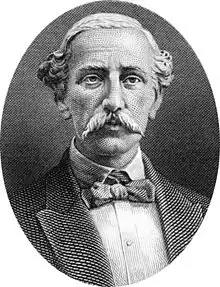
Although Duarte was supported by many as a candidate for the presidency and Mella even declared him president, Duarte declined arguing that he would only accept the position if the majority election of the Dominicans voted in his flavored. Instead, Tomas Bobadilla took office. Duarte was supported by many as a candidate for the presidency of the new-born Republic. Mella wanted Duarte to simply declare himself president. Duarte never giving up on the principles of democracy and fairness by which he lived, would only accept if voted in by a majority of the Dominican people. Duarte had a definite concept of the Dominican nation and its members. His conception of a republic was that of a republican, anticolonial, liberal and progressive patriot.
At that time he drafted a constitution that clearly states that the Dominican flag can shelter all races, without excluding or giving predominance to any. In his project for the Constitution, Duarte wrote that National Independence was the source of liberties and raised the need for Dominicans to have a fundamental law, in order to govern. The constitutional thought of Duarte expressed his most advanced conception regarding the organization of the State as a supreme organ of power.
One of the most important provisions contained in its draft Constitution says, among other things:[24]
-No power on earth is unlimited, not even that of the law-
-All Dominican power is and should always be limited by law and this by justice, which consists of giving each one what rightfully belongs to them-
Another very important part is the one that refers to the Powers of the State, whose division he conceives, in tripartite form in three parts, putting the Municipal Power, together with the Legislative, judicial and Executive powers. This disposition reveals the spirit of good sense and justice that always accompanied Duarte. It was intended to prevent rulers from making use of unlimited power, which could harm majorities.[24]
The constitutional ideas embodied in his Draft Constitution reflect the influence received by Duarte from the European ideologies of the 18th and 19th centuries. The conceptions expressed in this project allude that Duarte knew the works "The Social Contract," by Jean-Jacques Rousseau and "The Spirit of the Laws" by Montesquieu. In addition, American thinkers who inspired the United States Constitution of 1787 influenced the formation of Duarte's ideals, such as Thomas Jefferson and Thomas Paine.
Clashes with the Central Government Board, military coup of June 9, arrest and second exile
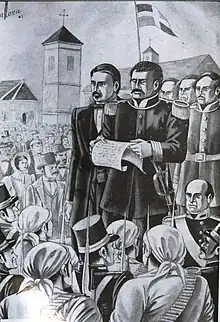
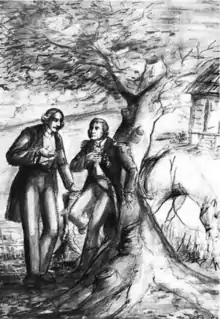

While these events were taking place, differences within the government continued to develop, as the group of conservatives continued their conspiracies for new protectorate plans. The Trinitarios, motivated by the fear that this situation caused them, requested that Duarte be appointed General in Chief of the Army, as well as other important positions for some Trinitarios.
Despite these precautions taken by the conservatives, they requested the protection of France to defend themselves against the Haitians, who once again threatened to occupy the country. On 9 June 1844, Duarte met in the Fortress with a group of soldiers and decided to take control of the government. Sánchez was appointed President and other members of the Cabinet were Pedro Alejandro Pina, Manuel María Valverde, Juan Isidro Pérez and Duarte himself. Now, the task of the Trinitarians was focused on discarding the influence of Santana and fighting against the actions of the group made up of conservatives. This was not possible because Santana had great influence in the government. Pedro Santana, aware of the military coup, wrote to the Central Government Board, requesting a medical license to retire from the army, on the pretext that he was suffering from an illness.[23]
Meanwhile, Buenaventura Báez and other conspirators communicated frequently with Santana and made a deal to get him approved for sick leave. General Sánchez was appointed assistant chief of Santana, but he was unable to fulfill that mission. Santana began preparing his plot and organized troops made up of his friends. He went to the city of Santo Domingo, with the purpose of "restoring order." After these events, on 4 July 1844, in the city of Santiago, Mella, who was Commander of the Department of Cibao, oblivious to what was happening in Azua with Santana, proclaimed Juan Pablo Duarte, President of the Republic. Duarte said that he would only accept that position if he was elected in democratic elections, in which all the peoples participated.[23]
Meanwhile, Santana was approaching the capital city with an army made up of more than two thousand soldiers. The French consul threatened the members of the Junta with intervention if they confronted Santana militarily. Some soldiers were pressured and Colonel Puello, Chief of the Plaza, denied support for the Trinitarios. After Santana's entry with his troops, he rallied his supporters. Colonel Antonio Abad Alfau harangued the soldiers, who received the soldier under the cry: Down with the Junta! Long live General Santana! [23]
On 15 July 1844, Santana met with the members of the Governing Board to present their purposes. When Sánchez refused to cooperate, Santana, in revenge, ordered Sánchez's arrest. A month later, in a document drafted by Tomás Bobadilla y Caminero, the Junta chaired by Santana declared, among other things:[23]
To punish all the authors of the sedition, headed by General Juna Pablo Duarte (...) Declares that Brigadier Generals Duarte, R. Mella, Fco. del Rosario Sánchez, Commanders Pedro Alejandro Pina, Gregorio del Valle, Captain JJ Illas and Mr. Juan Isidro Pérez... They have been traitors and unfaithful to the Homeland and as such unworthy of the jobs and charges they held, of those who were deposed and dismissed from this day on.
The first deportees by Santana were: Mella, Pina and JJ Illas, a Venezuelan poet, friend of Duarte. Duarte was arrested in the city of Puerto Plata, in the house of Mr. Pedro Dubocq. Next to him were Juan Evangelista Jiménez and other companions. On 2 September 1844 in a ship captained by Juan Bautista Cambiaso. Upon arriving in the capital, the Patrician was locked up in La Torre del Homenaje, (present-day Ozama Fortress).[23] The imprisoned revolutionaries were then sent to exile in Hamburg. He spent nineteen days in the city, where he interacted with members of Freemasonry, an institution which belinged a few years before, as was common among people of certain educational level in the country.[25] His short stay in Germany can be attributed to the fact that he was interested in being as close to his homeland as posible. After a brief stay in Hamburg, on 30 November, Duarte moved to the Caribbean island of Saint Thomas, where he rejected offers to enter the service of Haiti or Spain to oppose Santana. From there, he moved to La Guaira, Venezuela, where his entire family, now plunged into misery, had also been exiled by Santana.
Duarte's family in Venezuela did not do too badly, they lived and worked in an affluent area. Duarte's cousin Manuel Diez became vice president of the country and helped shelter his kinsman. Duarte's family was known to produce candles, this was a major retail and wholesale product since light bulbs for lighting had not been invented yet. While not luxuriously rich an income was available for the Duarte's. Juan Pablo being a man of action as well of a high level of curiosity went off to live in the Venezuela, there he had some contacts and he made off to meet with them. The Venezuela of this period was wracked by a series of civil wars and internal dissensions. Duarte even though he and his family were already by this time residents of the country, still felt ambivalent about openly participating in the country's political life, all this despite the fact that the aforementioned cousin Manuel Antonio Díez from the vice presidency, went on to become President of Venezuela in an Ad Tempore capacity.
Duarte travels in Venezuela involved studying the indigenous people's and learning from the black and mulatto communities as well as observing as much as he could of the Venezuela of his time. Duarte was an extremely educated man, fluent in many languages, he was a former soldier and teacher. These abilities helped him survive and thrive in those places he travelled. It also marked him as an outsider, given the fact that he was of Caribbean descent, he probably sounded much different than most of the Spanish speakers around him. However, Santo Domingo and the Republic that he had helped father were also highly likely always close to his heart and his mind. So he was very much a man divided, excited and deeply moved by the current surroundings, people's and events around him, however very much thinking about his beloved land and people whom he sacrificed so much for. A man in a contemplative mood, wounded by the drastic expulsion such as he suffered, would have very little time for a long term wife, children or true stability.
Restoration of Dominican independence
Prelude to annexation
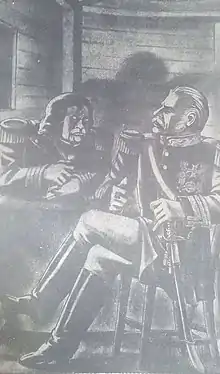
Within the 17 years of the First Republic, the nation was ravaged with political and economic instability. The Haitians attempted on numerous occasions to regain control over the Dominican part of the island, but were defeated again and again. Political power passed to the conservative group of hateros and former Frenchified boyerista officials, thanks to the control of the presidency of the Central Government Board by Bobadilla and of the Liberation Army by General Santana, who ruled dictatorially in various periods. As time progressed, the constant power struggles between Santana and Buenaventura Báez, a hatero and woodcutter from the southwest of the country, more cunning and no less annexationist than the former, set the stage for a period of political and economic chaos.[16]
Between 1853 and 1857, Santana and Báez engaged in a series of political confrontations that eventually reached its breaking point with the outbreak of the Cibano Revolution during Báez's second term in office. All the while, both would continue to propose that the Dominican Republic be annexed to a foreign power, with Santana choosing Spain, and Báez subjecting the United States. With Báez's overthrow in 1858, Santana once again president. But by now, the nation was on the brink of collapse due to the heavy spending of the war, and the bankrupt treasury left behind from Báez administration. All of this, in addition to fears of a renewed Haitian invasion, led to Santana to seek out the proposals from Queen Isabella II of Spain.
Sánchez and Mella, however, did not abandon their liberal positions and patriotic essentials. Their relationships with prominent conservatives was the price to remain in the interior of the country and influence so that things could take the best possible direction. Duarte, however, saw things differently. He believed it was impossible to accept any type of agreement with what he described as "faction." According to a letter from Juan Isidro Pérez, Duarte was disappointed in Sánchez, whom he had placed in charge following his 1843 exile, due to reaching an agreement with Santana. For Duarte, patriotism of the people was the only possible cause, therefore he refused to conceive the existence of the parties, only recognizing the opposition of traitors. Referring to Báez and his early inclination in favor of the United States, he wrote in 1865:[26]
In Santo Domingo, there is only one town that wants to be and has proclaimed itself independent of all foreign power, and a miserable fraction that always has spoken out against this law, against this need of the Dominican people, always achieving by gave of his intrigues and sordid dealings to take over the situation.
Duarte preferred complete isolation to any concession. Politics had to be guided by noble purposes or it would be distorted. Consequently, politics implied high ideals, reflection and action for the benefit of the community. Above all things, for Duarte, politics was equivalent to patriotism. His notion of a free country, which was synthesized in the willingness to sacrifice in favor of the principles and the well-being of the people, was the opposite of the common-mind considered as politics: the realm of the struggle for power.[27]
Assistance from Venezuela

Although many aspects of his life in Venezuela remain unknown, it is certain that Duarte did not abandon the disposition to action. When sensing danger approaching his country, he did not hesitate to present himself. It was when he learned of the annexation of the Dominican Republic to Spain in March 1861, news that he received more than a year later in the depths of the Venezuelan jungle, and moved to Caracas in August 1862. During the following months, he remained mainly in expectation. It can be deduced that he considered that his prolonged absence from the county is what caused him not to take initiatives. Some even argue that Duarte felt regret for the country, since apparently the majority of the population accepted Santana's betrayal.[27]
It was when the Restoration War broke out, in August 1863, when Duarte started moving. His sister's Diary was stated that on 20 December 1863, he moved to Caracas with his uncle Mariano Diez. As soon as he found out that the people had begun the fight against Spanish domination, Duarte formed a revolutionary center in Caracas. His brother Vicente Celestino, his uncle Mariano Diez, the young poet Manuel Rodríguez Objío and the Venezuelan Candelario Oquendo joined him. Several Venezuelans were interested in supporting the Dominican cause, those who stood out between Blas and Manuel Bruzual the latter known as The Fearless Soldier, exponent of the radical positions of liberalism. President Juan Crisóstomo Falcón received Duarte and promised him help, despite the difficult situation in which Venezuela found itself, after several years of federal war. Despite Falcón's good disposition, the help received by Duarte was minimal, since the matter was left in the hands of the vice president, Antonio Guzmán Blanco, (future autocrat of Venezuela), who was not interested in helping the Dominicans. Duarte reflected that In matters of intrigue, Venezuelans were no different from the Dominicans. Apparently he only received a thousand pesos from the Venezuelan government. Many Dominicans came to stand at Duarte's orders, but he could not do anything due to lack of funds. Therefore, without having managed to gather resources, as was his wish, together with the four aforementioned companions, he was able to embark in Curaçao towards Montecristi in March 1864. After 20 years of exile, he was now back in his homeland.[28]
Second return to Dominican Republic
He arrived in Monte Cristi in April 1864 and immediately addressed the government of the Restoration. Upon arriving in Santiago, he was able to give a final greeting to his partner Mella, vice president of the government, who was dying of cancer. In the interviews he had with Ulises Francisco Espaillat, in charge of the government, Duarte asked to be assigned to the combat front expressed his interest in meeting the president José Antonio Salcedo.The restoration government did not evaluate the importance that it had the presence of Duarte, which could have been due to the fact that his figure had has been buried by oblivion and that some of the leaders of the national contest had been supporters of Santana.[28]
On April the government of Santiago, through Espaillat, Duarte was asked to move to Venezuela at the head of a diplomatic mission in order to get help. He was not willing to accept the assignment, because his interest was to participate in the struggle in the interior of the country. But, a few days later, an article published in the Diario de la Marina, in Havana, was received, signed by G. (who could have been the writer Manuel de Jesús Galván, the main Dominican spokesperson of the Spanish regime in Santo Domingo), which predicted internal struggles among the restaurateurs for control due to the return of Duarte. So that it could not be thought that he was motivated by personal ambitions, Duarte informed Espaillat that he accepted the appointment, although for a few days he hoped to remain in the interior of the country. Espaillat, however, confirmed Duarte's appointment, although he told him that he should not stay with the impression that G.'s intrigue had had an effect. Again in Venezuela, it was impossible for him to obtain support for the Dominican struggle. The Restoration was an epic that the Dominican people had to wage without any external support, but thanks to the tremendous sacrifice of poor farmers, who gave the bulk of their crops for the purchase of weapons through Haiti.[29]
Final years and death
Post-Restoration War
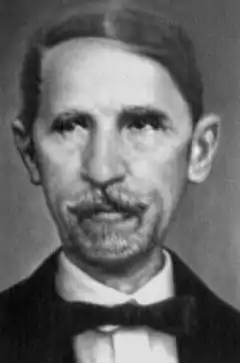
Duarte closely followed the evolution of the country, as shown in the active correspondence he had during those months, although he resigned from diplomatic representation following the overthrow of President Gaspar Polanco, who had released his credentials. He was above all concerned about the recomposition of annexationism, this time in favor of the United States, which was promoted mainly Buenaventura Báez. That is why he pointed out in a letter to Félix María Delmonte:[30]
If after twenty years of absence I have spontaneously returned to my country to protest with arms in hand against the annexation to Spain carried out despite the national vote for the deception of that traitor and parricide side, it is not to be expected that I stop protesting (and with me every good Dominican) which I protest and will always protest, I'm not just saying against the annexation of my Country to the United States, but to any other power on earth, and at the same time against any treaty that tends to undermine in the least our National Independence.. [...]
From the end of 1865, Dominican politics moved away of the patriotic objectives stated in the Restoration. Most of the leaders who emerged from that war oriented toward anarchic and conservative positions. Duarte must have assessed the poverty of the political leadership, as he refers in another letter to Delmonte on May 2 of that year:[31]
You say (and it is true) that Benigno Rojas is nothing but Yankee, and Báez who is nothing but Haitian-Gallo-Spanish, and Lavastida and Alfaus and Manueles are Yankees; Báez says that says that Bobadilla is nothing but Pandora, Melitón is everything, except Dominican, says José Portes who is in Saint-Thomas, and adds to this that being a senator, so that he would keep his mouth shut when the Annexation, Santana gave him a house. Poor country! If these are the consultants, what will be consulted?
He was said to have experienced new disappointment when he saw that the old annexationist, Buenaventura Báez, the architect of the Levasseur Plan of 1843, was elevated to the presidency, brought by none other than the then president José María Cabral, champion of the Restoration in the south. From then on, although he did not leave Caracas, he disassociated himself from Dominican politics. The country entered a whirlwind of passions between leaders and a difficult situation in which annexation to the United States was approved in 1870. Practically, everyone forgot about Duarte; Occasionally he received visits or correspondence from liberal intellectuals interested in the reconstruction of the events that led to the birth of the Republic.[31] Gregorio Luperón, the hero of the Restoration War, made efforts to return Duarte back to the country. In addition, Duarte received a letter from President Ignacio María González, who invited him to reintegrate into the Dominican Republic. But by now, Duarte was in extreme poverty and his health was fading rapidly. Therefore, he could not respond to these calls for his return.
Death
On 14 July 1876, Duarte's health was seriously deteriorating. Suffering from turbercolisis snd pnemonea, his breathing had worsened, causing him to be confined to his bed. In his final moment, he was accompanied by sisters Rosa and Francisco, and his brother, Manuel. F. Pérez narrates that gloomy day in these terms:[32]
Caracas, on the night of July 14, 1876, Duarte was approaching his end and while his sisters, Rosa and Francisca, watched by his side; His brother Manuel, lost her mind, was shooting nonsense in a neighboring room. The most complete misery prevailed in the house, whose furniture was very scarce. Rosa and Francisca lived by sewing and their earnings were so meager that they could barely survive. Such was the environment in which Duarte was close to death, after suffering for a year from an exhausting illness (pneumonia) that turned him into a ghost. He was 63 years old and looked over eighty. A life of illness, deprivation and sacrifice had reduced him to that pitiful situation. For his neighbors in Caracas, Duarte was a Dominican who had had some importance in his country or at least that was what it seemed. What these people did not know was that if the Duartes were in such a terrible situation, it was due to the love they felt for their country because on two occasions, in 1844 and 1863, they sacrificed an important part of the family heritage for it.
Nor did they know that that old man, who looked abstracted and sick, had been one of the purest patricians in America, who had dedicated himself to serving his country with “soul, life and heart.”
And they did not know that this poor Dominican, who lived so darkly, had been considered the Nazarene Jesus of the Dominicans.
As for their sisters, those same people were unaware that those poor women, who now did not even have good eyesight to sew, together with their mother, now deceased, had manufactured more than 5,000 bullets for the independence of their country.
But let's go back to the patient.
At two in the morning on Saturday, silence enveloped Caracas.
The night advanced and the city looked deserted.
In the sad Duarte house, Rosa and Francisca kept vigil.
Everything announced the proximity of the end, and in the dying man's room, poorly lit by a candle, prayers alternated with silence.
The time advances and the patient's breathing becomes more difficult. The wait is long.
Finally, at three in the morning, on July 15, 1876, the dying man breathed his last sigh.
The room is filled with sobs.
Rosa and France bloom inconsolably.
Duarte is dead.
The first news of his death was announced through the Diario de Avisos, of Caracas, in the afternoon edition of July 15, 1876. The note states the following:[33]
General (sic) Juan Pablo Duarte, leader of Dominican independence, has died; His relatives and friends who subscribe hope that you will accompany them to the burial of the body tomorrow at 9 am in the IP of Santa Rosalía." - Caracas, July 15, 1876.
Personal life
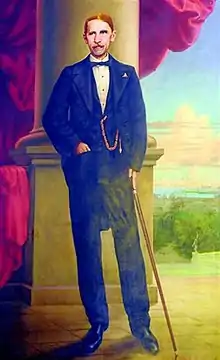
Duarte's personal life to date is the subject of discussion. It is known that he was a poet who followed Romanticism. He also used to play the guitar, the piano and the flute; he also practiced fencing.
During his youth, Duarte had several love affairs. His first relationship was with María Antonia Bobadilla, which she ended years later for unknown reasons. The Duarte Museum is said to have preserved the ring in which he gave to her as a sign of commitment. Years later, Duarte fell in love with Prudencia "Nona" Lluberes, a Catalan descendant with whom he formalized a relationship that was interrupted due to his exile and his subsequent suffering from tuberculosis. The dates on which Duarte maintained these relationships are not known, given the imprecision about his private life and the last years of his life in exile. Some historians also certify that he had a son during his stay in Venezuela with a woman named Marcela Mercedes.[34]
Jose Joaquin Perez Saviñon, director of the Duartiano Institute, commented on Duarte's first love story: "For unknown reasons, the engagement was broken." But Duarte would have the opportunity to fall in love again, this time with a descendant of Catalans and a relative of various patriots, Prudencia Lluberes, La Nona. Troncoso Sánchez says in Apuntes Duartianos that "his second girlfriend received, like his first, his promise of marriage symbolized in a ring."
Always persecuted by his ideals, Duarte loved, but could not continue with Prudencia "Nona" Lluberes. Pérez Saviñón comments that Yovanny Ferrúa wrote an article highlighting that already in exile, Duarte wanted to marry her by her power, but they did not let him because he already suffered from tuberculosis. "They even tore up the letters he sent her for fear of contagion from her, which is why Duarte's love letters are not preserved," says the president of the Duartiano Institute.[34]
Pérez Saviñón assures that Prudencia always hoped and dreamed of the Father of the country. She never married. Saviñón ecxplained:[34]
When they brought Duarte's remains, Nona lived in front of the Colón park and they took her out onto the balcony already blind, very old and it is said that she said: 'I have followed you up to here Juan Pablo,' and after a few months she died," she narrates.
While the country maintains the version that Duarte never married, much less that he had children, Bulletin 117 of the General Archive of the Nation, called "The Duarte family: Genealogy at the service of history," Antonio José Guerra Sánchez refers to the Theories of the descendants of Juan Pablo Duarte Díez.
Guerra Sánchez says:
At different times, some authors (including the journalist and historian Luis Padilla D'Onis, originally from Arecibo, Puerto Rico) have tried to indicate descent from Patricio Juan Pablo Duarte, through his cousin Vicenta Díez, in her daughters Carmen Sandalia and Sinforosa Duarte Díez.
However, he adds that it is unknown that there was a Vicenta Díez and even less is known of which of the brothers of the mother of the hero was her daughter.
What is certain is that Duarte did not marry, and according to Pérez Saviñón he did not “because he clearly said that he had married the country, all his efforts were for the country. The love for the homeland was superior to everything, even though he was already a defeated old man, he still thought about the homeland. He sacrificed himself for his spirit of service," he says.
Writings
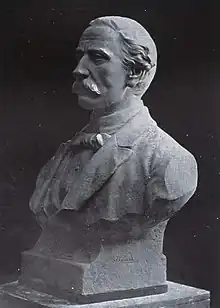
Aside from his stature as a revolutionary leader, he was also known as a writer. Duarte did not pretend to be a poet, as Don Vetilio says, although he liked poetry as demonstrated by his published verses, including some saved poems, which he wrote when he was almost lost in the Venezuelan jungle. His poetry, as Ángela Peña points out, is “an extension of his patriotic and political work, even though there are poems of his in which he sings to women. It cannot be considered that the Father of the Nation was a poet. Literary creation was not a habit in his life. He wrote responding to the imperatives of the moment without having poetry as a constant and permanent way of expression." Among the known poems, written by Juan Pablo Duarte in Santo Domingo, are Tristezas de la noche, Santana, Canto de guerra, Antifona, El Criollo, Desconsuelo, Suplica, Himno, La Cartera del proscribado, and four other poems without titles.
In his romantic production, is the poem Romance, the theme of bitterness is evident. Remoteness portrays the stormy pain of feeling expatriated from her land along with her eight companions in misfortune, those who gave everything to see her free and sovereign:
“ /…/ They who will launch themselves in the name of God, / Homeland and freedom; / They who gave the People / The desired independence. / They were thrown from the ground / For whose happiness they fought: / Outlawed, yes, by traitors / Those who were in excess of loyalty. / They were watched descend / to the quiet shore, / They He heard them say goodbye,/And from their muffled voice/I picked up the
However, of the writings in his eventful years of exile, there are only a few verses without titles, contributed by the Venezuelan historian Francisco Manuel de las Heras y Borrero in his essay Juan Pablo Duarte in Venezuela, written while he lived in Chaguas: “Here the Patricio will participate in literary and social gatherings, avoiding overtly political ones, given his refugee status. (…). Duarte's presence in this geographical location is clearly identified in 1856, the year in which the first book published in Apure was published. These are the Posthumous Honors of Mr. Marcelino Muñoz (…). In the reviewed publication, a poem by Juan Pablo Duarte appears, dedicated to extolling the merits of the deceased, his friend, "who was the president of the Masonic Sociedad Joven Achaguas, which Juan Pablo Duarte frequentedHere are the verses contributed by de las Heras and Borreros:
“Of paragon honor and model virtue,/ I call that impious world his own,/ and Heaven said without mercy, without mourning,/ with a tremendous voice “Marcelino is mine.” / And he heard that ruling, and without moaning in pain / with a calm, religious and pious face. / Goodbye he said to us with a serene face, / he who was from Apure the spirit. / And when the poor foreigner / sees himself sick and helpless, / who like the softened / will give him whole bread and home?
Legacy and honors

Duarte managed to establish a free Republic, which through the voting process, could give rise to a democracy where all citizens, in theory, could be equal and free. The study trips he made to Europe in his adolescence, a continent where liberal ideas resulting from the French Revolution were debated and imposed, greatly influenced his later attitudes in the independence struggles.[35]
He is considered a national hero and father of democracy in the Dominican Republic. He is also credited with being the precursor of Dominican theater by being the first to promote theatrical events through the La Filantrópica and La Dramática societies, which aimed to present theatrical works alluding to Dominican freedom.[35]
One of his most emblematic phrases was without a doubt "Living without a country is the same as living without honor!" This quote left a great mark on the Dominican people.[35]
His birthplace was converted into a museum. The Duarte-Diez family lived there from their arrival in Santo Domingo until their exile.
- Duarte's birth is commemorated by Dominicans every January 26.
- Many places in the Dominican Republic bear his name, among them the country's (and the Caribbean's) highest point, Pico Duarte.
- Duarte is solely depicted on the one Dominican peso coin; he is also depicted on the 100 Dominican peso note alongside Sánchez and Mella.
- A memorial to Duarte stands in Roger Williams Park in Providence, Rhode Island[36]
- Broad St. in Providence, Rhode Island co-named Juan Pablo Duarte Boulevard
- A bronze statue to Duarte was erected at the intersection of 6th Avenue and Canal Street in New York City in 1978.[37]
- St. Nicholas Avenue in Manhattan is co-named Juan Pablo Duarte Boulevard from Amsterdam Avenue and West 162nd Street to the intersection of West 193rd Street and Fort George Hill.[38]
- Puente Juan Pablo Duarte is a suspension bridge that is located in Santo Domingo; it was named after him.[39]
- A bust of Duarte at the Permanent Mission of the Dominican Republic to the Organization of American States was dedicated in 2010.
Works
- Tristezas de la noche
- Santana
- Canto de guerra
- Antífona
- El Criollo
- Desconsuelo
- Suplica
- Himno
- La Cartera del procrito
- Romántica
See also
- France-Haiti relations
- Dominican Republic-Spain relations
- Haiti-United States relations
- Dominican Republic-Haiti relations
- History of the Dominican Republic
- Republic of Spanish Haiti
- Haitian occupation of Santo Domingo
- Dominican War of Independence
- Dominican Restoration War
- Juan Sánchez Ramírez
- José Núñez de Cáceres
- Francisco del Rosario Sánchez
- Matías Ramón Mella
- La Trinitaria
- Pedro Santana
- Tomas Bobadilla
- Gregorio Luperon
Notes
- ↑ His paternal grandparents were Manuel Duarte Jiménez and Ana María Rodríguez de Tapia, both from Vejer de la Frontera (Kingdom of Seville, Spain). His maternal grandparents were Antonio Díez Baillo, from Osorno la Mayor (Province of Toro, Spain), and Rufina Jiménez Benítez, who was born in El Seybo (Captaincy General of Santo Domingo, New Spain).[5]
References
- 1 2 "Juan Pablo Duarte Biography". Biography.com. 2010. Archived from the original on 2010-09-11. Retrieved 2010-07-26.
- 1 2 "Biografia de Juan Pablo Duarte". Archived from the original on 2019-01-21.
- ↑ Serra, José María (1887). Apuntes para la historia de los trinitarios. Santo Domingo: Imprenta García Hermanos.
- ↑ Mendez Mendez, Serafin (2003). "Juan Pablo Duarte". Notable Caribbeans and Caribbean Americans: A Biographical Dictionary. Greenwood Publishing Group. p. 148. ISBN 0313314438.
- ↑ González Hernández, Julio Amable (23 October 2015). "Los ancestros de Juan Pablo" (in Spanish). Archived from the original on 12 July 2012.
- ↑ www.colonialzone-dr.com
- ↑ Deive, Carlos Esteban (1989). Las emigraciones Dominicanas a Cuba, 1795-1808. Santo Domingo: Fundación Cultural Dominicana.
- ↑ "Hispaniola Article". Britannica.com. Retrieved 4 January 2014.
- ↑ "Dominican Republic 2014". Retrieved 24 April 2014.
- ↑ Lora Hugi, Quisqueya. "El sonido de la libertad".
- ↑ Mackenzie, Charles (1830). Notes on Haiti made during a residence in that republic. London: Henry Coleburn and Richard Bentley. p. 235.
- ↑ "Venezuela tiene deuda histórica con Haití". 6 January 2014.
- ↑ Cassa, Roberto (2008). Padre de la Patria (in Spanish). Santo Domingo: Alfa y Omega. p. 15. ISBN 9789945020380.
- ↑ Diario, Listin (2012-01-28). "Viaje a Norteamérica y Europa". listindiario.com (in Spanish). Retrieved 2023-04-16.
- ↑ Diario, Listin (2012-01-26). "El Duarte viajero". listindiario.com (in Spanish). Retrieved 2023-04-16.
- 1 2 "Biografia de Juan Pablo Duarte". www.biografiasyvidas.com. Retrieved 2023-03-13.
- 1 2 "JUAN PABLO DUARTE, Biografía completa – Historiando con Vicente Florian" (in Spanish). Retrieved 2023-04-14.
- 1 2 sanchez, mirtha (2021-03-12). "Biografía de Juan Pablo Duarte (página 2)". Monografias.com (in Spanish). Retrieved 2023-04-16.
- 1 2 3 4 "Exilio de Juan Pablo Duarte y fusilamiento de los trinitarios (3)". Acento (in Spanish). Retrieved 2023-08-10.
- 1 2 Cassá, Roberto (2008). Padres de la Patria (in Spanish). Santo Domingo, Dominican Republic: Alfa & Omega. p. 25. ISBN 9789945020380.
- ↑ Cassá, Roberto (2008). Padres de la Patria (in Spanish). Santo Domingo, Dominican Republic: Alfa & Omega. pp. 25–26. ISBN 9789945020380.
- 1 2 "Juan Pablo Duarte a punto de salir al exilio; se mantiene la persecución de autoridades haitianas". Vanguardia del Pueblo (in Spanish). 1843-07-31. Retrieved 2023-08-11.
- 1 2 3 4 5 6 7 Euloarts (2013-02-19). "El regreso de Juan Pablo Duarte al país". Euloarts (in Spanish). Retrieved 2023-08-10.
- 1 2 "Universitario | Contexto político predominante impedía Proyecto Constitucional de Duarte". 26 October 2017. Retrieved 2023-08-11.
- ↑ Cassá, Roberto (2008). Padres de la Patria (in Spanish). Santo Domingo: Alfa y Omega. p. 34. ISBN 9789945020380.
- ↑ Cassá, Roberto (2008). Padres de la Patria (in Spanish). Santo Domingo, Dominican Republic: Alfa & Omega. pp. 35–36. ISBN 9789945020380.
- 1 2 Cassá, Roberto (2008). Padres de la Patria (in Spanish). Santo Domingo, Dominican Republic: Alfa & Omega. p. 36. ISBN 9789945020380.
- 1 2 Cassá, Roberto (2008). Padres de la Patria (in Spanish). Santo Domingo, Dominican Republic: Alfa & Omega. p. 37. ISBN 9789945020380.
- ↑ Cassá, Roberto (2008). Padres de la Patria (in Spanish). Santo Domingo, Dominican Republic: Alfa & Omega. pp. 37–38. ISBN 9789945020380.
- ↑ Cassá, Roberto (2008). Padres de la Patria (in Spanish). Santo Domingo, Dominican Republic: Alfa & Omega. pp. 38–39. ISBN 9789945020380.
- 1 2 Cassá, Roberto (2008). Padres de la Patria (in Spanish). Santo Domingo, Dominican Republic: Alfa & Omega. p. 39. ISBN 9789945020380.
- ↑ Motín, El (2022-07-16). "Cómo murió Juan Pablo Duarte". El Motín (in Spanish). Retrieved 2023-10-22.
- ↑ Diario, Listin (2023-07-15). "La enfermedad del patricio Juan Pablo Duarte, su última batalla". listindiario.com (in Spanish). Retrieved 2023-10-22.
- 1 2 3 Jesús, Elizahenna Del (2019-02-13). "La vida amorosa del patricio Juan Pablo Duarte". Plan LEA (in Spanish). Retrieved 2023-08-11.
- 1 2 3 "JUAN PABLO DUARTE, Biografía completa – Historiando con Vicente Florian" (in Spanish). Retrieved 2023-11-12.
- ↑ "Historic Figure: Juan Pablo Duarte - Providence, RI". Photo-Ops. 14 November 2016. Retrieved 19 April 2017.
- ↑ "Duarte Square". NYC Parks. NYC Parks Department. Retrieved 19 April 2017.
- ↑ "Mayor Giuliani Signs Bill That Names Section of St. Nicholas Avenue in Honor of Juan Pablo Duarte" (Press release). New York City Mayor's Office. February 22, 2000. Retrieved 2010-05-29.
- ↑ "Así fue el domingo minutos antes y después del toque de queda en la capital". 2 August 2020.
External links
- Haggerty, Richard A., ed. (1989). Dominican Republic: A Country Study. Federal Research Division. Haiti and Santo Domingo.

